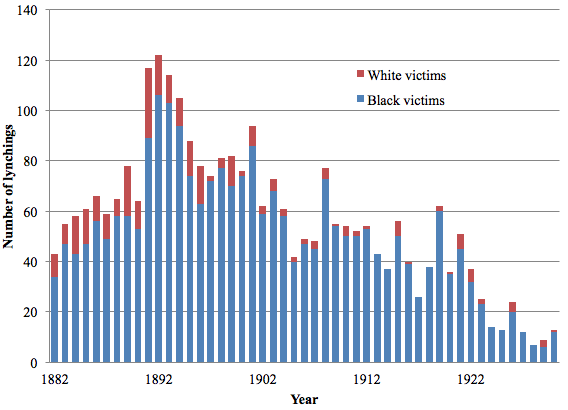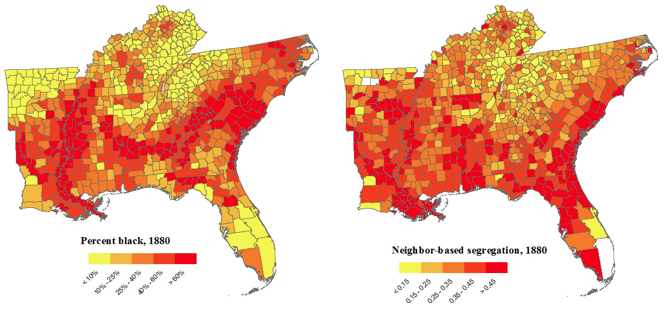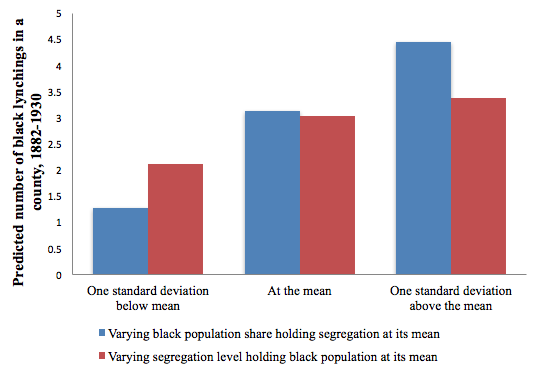This is Naked Capitalism fundraising week. 1583 donors have already invested in our efforts to combat corruption and predatory conduct, particularly in the financial realm. Please join us and participate via our donation page, which shows how to give via check, credit card, debit card, or PayPal. Read about why we’re doing this fundraiser,what we’ve accomplished in the last year and our current goal, more original reporting.
By Lisa Cook, Associate Professor in the Department of Economics and in International Relations, Michigan State University, Trevon Logan, Hazel C. Youngberg Trustees Distinguished Professor in the Department of Economics, Ohio State University and John Parman, Associate Professor in the Department of Economics, College of William & Mary. Originally published at VoxEU
Lynchings in the American South reached their peak in the 1890s, but their impact persists today. This column applies a new measure of segregation to data on the incidence of lynchings to confirm earlier findings that counties with larger black population shares were more likely to experience lynchings, but also that greater segregation of the black population increased lynching activity. These findings demonstrate that residential segregation matters in rural areas for both intergroup relations and the economic and social outcomes that depend on those relationships.
A growing body of empirical evidence documents important impacts of ethnic diversity and ethnic conflict on both economic and social outcomes. In the US context, economists typically focus on the influence of ethnic diversity on urban economic outcomes, with mixed results. While some studies document economic benefits of diversity in urban areas (e.g. Ottaviano and Peri 2006), others find that increased diversity is associated with lower levels of social capital (Costa and Kahn, 2003), public goods provision (Alesina et al. 1999) and economic growth rates (Alesina and La Ferrara, 2005).
One limitation of this literature is a lack of historical depth. Ethnic and racial divisions are inherently historical processes which play out over time and which can have persistent effects, from altering paths of development to becoming cultural norms. Consider the long-run impacts of America’s dark history of interracial violence in the form of lynchings, which most often involved white mobs targeting black victims. Lynchings reached their peak in the 1890s, as seen in Figure 1, yet their impact persists to this day (Messner et al. 2005). One visible consequence of the long history of discrimination and interracial violence faced by black Americans is the modern gap in trust levels in the US, where black individuals are 24% less likely to trust others than non-black individuals (Alesina and La Ferrara 2002). These modern trust levels are lowest in those states that experienced the highest levels of lynchings in the early 20th century, with Mississippi, Alabama, and Arkansas among the states with the highest number of lynchings historically and the lowest levels of trust today. These same states also have some of the lowest average incomes and levels of public goods in the country today. Understanding the nature of lynchings and other forms historical intergroup conflict is crucial to understanding modern attitudes, institutions, politics, and economic performance.
Figure 1 Number of lynchings in the American South by year and race of victim

Source: Project HAL (Historical American Lynching) database.
Investigating the causes and consequences of violent racial conflict in America’s past requires pushing the existing literature on ethnic diversity and conflict in two understudied directions.
- First, it requires shifting the focus to rural rather than strictly urban communities.
- Second, the spatial distribution of racial groups, rather than simply their population shares, must be emphasised.
Historically, racial violence in the form of lynchings was particularly concentrated in America’s rural communities. These are areas that continue to show complicated links between anti-minority attitudes, political attitudes, public goods provision, and intergroup conflict (e.g. Tope et al. 2015, Kimmel and Ferber 2000). Furthermore, these areas span both majority-white and majority-black communities in the past and present. Group population shares alone – the focus of much of the ethnic fractionalisation and conflict literature – fail to identify the spatial distributions of these populations. However, spatial distribution is fundamental to understanding intergroup conflict. How segregated a group is will determine the extent to which that group interacts with members of other groups, interactions that can serve to either lessen or inflame tensions between groups.
Recent work by two of us on the rise of residential segregation in the US provides a way to directly address the spatial distribution of groups in rural populations (Logan and Parman 2017). We construct a new segregation measure that exploits the availability of the complete (100%) manuscript pages for the federal census to identify the races of next-door neighbours. We measure segregation by comparing the number of household heads in an area living next to neighbours of a different race to the number expected under random assignment, i.e. the number expected under complete segregation and under no segregation. Being defined at the household level means that the measure can be constructed simultaneously for urban and rural areas, for the first time giving us a consistent measure of segregation. The importance of having a measure of segregation to complement the population shares by race used in the existing literature is demonstrated by Figure 2. This figure depicts both percent black for Southern counties in 1880 and neighbour-based segregation for those same counties. While some areas of the South such as counties along the Mississippi had both high black population shares and high levels of segregation, generally the spatial patterns of black population share and segregation are quite different.
Figure 2 The distribution of the black population in the American South, 1880 as shown by black population share (left) and neighbour-based segregation (right)

Source: Logan and Parman (2017).
In a separate recent paper by all three authors, we match a county-level version of this new measure of segregation to the most comprehensive Southern lynching data available in order to assess how both the black population share and the segregation of that population were related to interracial violence (Cook et al. 2017). These lynchings span the years between 1892 and 1930 while our segregation data correspond to the year 1880. Thus, we are focusing on the impact of the pre-existing segregation of the black population on subsequent interracial violence, not on how the incidence of that violence drove changes in the residential location of black and white individuals.
Consistent with prior work on Southern lynching, we find that counties with larger black population shares were more likely to experience lynchings, as shown in Figure 3. However, with these new segregation data we are also able to demonstrate that the segregation of that black population was also critical in predicting lynching activity. We find that segregation was strongly correlated with lynching: increasing segregation from one standard deviation below its mean to the mean is associated with a 43% increase in the predicted number of black lynching victims, from 2.1 to 3 (Figure 3). Counties that were more segregated were much more likely to experience a lynching. Conditional on having a lynching, more segregated counties were more likely to experience multiple lynchings.
These findings are not the product of more segregated counties being generally more prone to violence or vigilante justice; we find that segregation is strongly correlated with lynchings involving a black victim, but uncorrelated with lynchings involving a white victim. Residential segregation was strongly correlated with interracial violence but had little effect on intraracial violence. This asymmetry in negative outcomes associated with lynchings involving black victims and white victims is consistent with the finding in Cook (2014), that significant diminished patent activity was associated with the former but not the latter.
Figure 3 The predicted number of black lynchings experienced by a county between 1882 and 1930 when varying black population share and segregation

Source: Cook et al. (2017).
These results shed new light on the United States’ history of interracial conflict. They demonstrate that segregation is an important factor in interracial violence in rural communities, which is where three quarters of the population lived in the South in 1880. The most recent literature on lynching emphasises region-wide phenomena, and here we see that local variation in racial segregation plays a role in lynching. That rural social organisation, as measured by residential segregation, was related to conflict is a new finding which expands the scope of research on ethnic and racial fractionalisation and social conflict to rural areas. Furthermore, our finding that greater residential segregation was associated with more lynchings helps us begin to sort through potential mechanisms underlying interracial violence. In the case of the American South, residential segregation did not allow the black community to insulate itself from interracial violence, nor did it serve as a substitute for interracial violence. Instead, racial segregation appears to have inflamed interracial conflict. This is a critical new finding to help us understand more generally the ways that residential segregation and intergroup contact influence intergroup conflict.
This exploration of America’s history of interracial violence helps us better understand the deep roots of racial tensions in the US today. However, it also emphasises a more general point that residential segregation matters in rural areas for both intergroup relations and the economic and social outcomes that depend on those relationships. Rural residential segregation grew tremendously during the first half of the 20th century (Logan and Parman, 2017) and remains particularly high throughout the country today (Lichter et al., 2007). Given that racial and ethnic dynamics in rural areas play a large role in contemporary national politics, public-goods provision, and public policy, further study of how rural segregation continues to influence those dynamics is crucial.
See original post for references


Some anecdotal “evidence” from a Deep South small city, Metro region population 50k +/-.
The incidence of interracial children appears more pronounced in the cities, where the black population migrated to due to social and economic forces over the last hundred and fifty years or so. Many towns here are majority black in population, or close to. Mississippi is almost racially half and half now. One result of the ex-slaves quite sensible rejection of the scenes of their travails was the need for the extension of the white small farmer class. Oligarchs being what they are, a great percentage of the white farming community in the American South became Sharecroppers. An older version of the Precariat, if you will. By cunning appeals to racial and personal feelings of insecurity, (yes, racial too,) the Elites of the time fomented ill will between the newly freed blacks and the newly indentured whites. (I assert that one can become de-facto indentured without recourse to legalism.)
I hesitate to suggest this, but I must if the issue is to be aired with any completeness; the populations remaining “on the farm” in the American South were mainly comprised of the less assertive blacks and more fearful, because recently defeated and newly exploited, poor whites. A perfect combination conducive to segregation and oppression was the result. Everyone was frightened and angry. Everyone was manipulated to blame the “others” for anything wrong with the times. (I do omit any long form discussion of who is doing the ‘manipulation’ simply for time and conciseness of argument.)
Another contributing factor that I have personally experienced and read about in numerous sources is; the inherent conservatism of farmers. Farming is hard work and often brutal in it’s demands and punishments. Two subjects constantly mentioned in descriptions of the inner lives of farmers are, the Weather, (often mentioned as if a God, or capricious demi-urge,) and Taxes (generally described as purely Infernal in origin.) Taken with the universally remarked propensity of farmers to treat women and children as free labour for the farm, this adamantine Pragmatism easily transfers to racial relations.
Finally, all of the above are aided and abetted by a perplexing concentration of “Bedrock” or “Fundamentalist” religious belief in the rural areas. Does the rural atmosphere engender Fundamentalism, or is it the other way around? (Are other countries’ rural populations hotbeds of “Primitive” religious practice, or am I mistaken in my argument? I’m not sure right now.) I do know that slavery is a given in both the Hebrew Old Testament and Christian New Testament. I remember arguing with a recent immigrant from South Africa about the status of blacks in the American South. His argument was, and he freely admitted the irrationality of it, that of the story of the fates of the sons of Noah. He stated that the inferiority of the “Sons of Ham,” a stand in for blacks, was taught to him in Sunday School as literal and God inspired. My point is that the early education of the population will set the parameters of that populations later lives and actions.
That’s enough ranting for now.
Thanks for this post. It’s amazing sometimes as I navigate social networks, I’ll see comments on posts or articles that are so clearly ignorant/oblivious of not just these events, but the effects of these events as they continue to shape our present … and future.
I for one believe we need more awareness of this – not to elicit guilt, as I recently saw someone comment recently elsewhere – but to understand what the effects were, and create path to understanding why our society needs to make amends.
I’d argue Diversity leads to greater social capital, especially down here in New Orleans. I remember reading this is my Political Participation Class @ LSU so u know it’s legit.
I’d hazzard a guess and say that: “Diversity leads to divergency.” At least in how diversity is practiced in America.
And, didn’t LSU PolySci give us such stalwarts as the Bald One and the Inclusive/Exclusive DNC chair? (Okay, that could have been LSU Lafayette.)